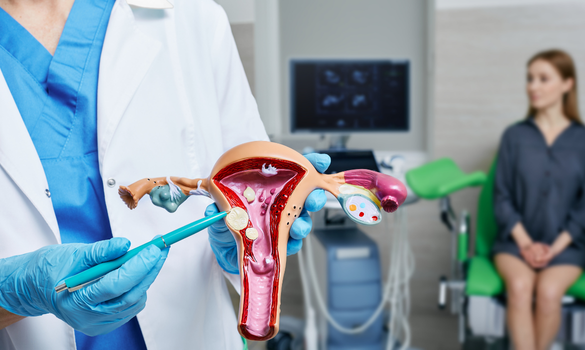Myomas are benign tumors that develop in or around the uterus in women. These formations, which are usually round in shape, occur in the smooth muscle tissue of the uterus. Although the exact causes of myoma formation are not known, hormonal changes and genetic predisposition play an important role. They are commonly seen in women between the ages of 30-50, but can occur at any age.
Myomas usually do not show symptoms and are detected incidentally during an ultrasound examination. However, in some cases, they can cause problems such as irregular menstrual bleeding, pain in the pelvic region, frequent urination or constipation. The size, number and location of myomas are important factors in determining the severity of symptoms and treatment method. Myomas are a frequently encountered topic when it comes to women's health.
What is Myoma
Myomas are tumors that develop in the uterus, usually consisting of benign muscle tissue. They are mostly seen in women of reproductive age and are related to hormonal changes. Myomas can be detected in 1 in 3 to 2 women at some point in their lives. Their sizes and symptoms can vary. While many myomas are diagnosed incidentally, a significant portion are also diagnosed by doctors during gynecological examination based on complaints.
Why Do Myomas Form
Myomas form due to excessive proliferation of smooth muscle cells of the uterus or blood vessels within the uterus. The most critical hormone in myoma formation is the female hormone known as estrogen. While myomas are not seen in the pre-pubertal period when estrogen hormone is absent, myomas begin to shrink during menopause when estrogen hormone decreases. Since estrogen hormone is higher during pregnancy than in pre-pregnancy periods, myomas grow rapidly during pregnancy.
Myoma Symptoms
Myoma symptoms vary depending on the size, location and number of myomas. Among the most common symptoms are:
- Increased Menstrual Bleeding: Long and heavy periods are common.
- Intermenstrual Bleeding: Bleeding may occur outside the menstrual period.
- Abdominal Swelling: Large myomas can cause noticeable swelling in the abdominal area.
- Infertility and Miscarriages: Myomas can make it difficult to get pregnant or cause pregnancy losses by affecting the anatomical structure.
- Pain and Pressure: Can cause symptoms such as frequent urination, constipation and back pain.
Symptoms can reduce the quality of daily life; therefore, it is critical not to ignore these symptoms.
How is Myoma Diagnosed
Diagnostic Methods
- Gynecological Examination: Increase in uterine size and irregularity may be indicators of myoma.
- Ultrasonography: It is a frequently used imaging method to determine the location, size and number of myomas.
- MRI and CT: Preferred for detailed examination in more complex cases.
- Pathological Examination: May be necessary to confirm diagnosis and rule out the possibility of a malignant tumor.
When diagnosis is made, your doctor draws a roadmap to determine the most appropriate treatment methods for you.
Myoma Treatment Methods
There are multiple treatment options available for myomas. For myomas that are thought to only cause irregular bleeding, and where no pathology is detected in pathological examination of samples taken from the uterus, many treatment options are available from non-steroidal anti-inflammatory drugs to intrauterine hormonal devices and oral hormones to reduce bleeding. The important point here is that it must be clearly demonstrated that there are no abnormal cells in biopsies taken from the uterus. Because in patients with myoma, thickening (hyperplasia), polyp or cancer may also be present simultaneously in the uterus. If bleeding is attributed to myoma and delayed, it may cause delay.
Myoma treatment is shaped according to individual needs. The patient's age, complaints, desire to have children are factors that affect the treatment plan. Treatment options are:
Medical Treatment
May include hormone-regulating medications or intrauterine systems. The goal is to relieve complaints and ensure myomas shrink.
Surgical Treatment
Surgical treatment for myomas is applied in cases of large myomas, those suspected of cancer, those causing reproductive problems, or when desired response is not obtained with medical treatment. Surgical treatment can be performed with different methods depending on the size, number and location of myomas. The most commonly used surgical methods are:
- Myomectomy: It is an operation where only myomas are removed while preserving the uterus. It is a suitable option for patients planning to have children.
- Hysterectomy: It is an operation that involves complete removal of the uterus. It is generally preferred in patients whose reproductive period has ended or who do not benefit from other treatment methods.
- Laparoscopic or Robotic Surgery: These are surgical procedures performed with less invasive methods. They provide shorter recovery time and lower complication risk.
Which treatment method will be applied is determined according to your doctor's recommendations and your lifestyle-related preferences.
Take a Step for Your Health Today
Myomas are a health issue that should not be ignored. If symptoms are affecting your quality of life or if you suspect myoma, do not delay getting a professional evaluation.
Frequently Asked Questions (FAQ)
1. How risky are myomas for women planning pregnancy?
Depending on the size of myomas and their location in the uterus, there may be a risk of preventing pregnancy. Especially myomas located close to the uterine cavity can make embryo implantation difficult or cause miscarriages. In this case, the treatment plan should be shaped according to pregnancy plans.
2. Is there a risk of myomas turning into cancer?
Myomas are generally benign. However, in very rare cases, malignant cells (leiomyosarcoma) may be present in myoma-like masses. Therefore, pathological evaluation after surgery is recommended for rapidly growing or suspicious-looking myomas.
3. How is the recovery process after myoma surgery?
Recovery time varies according to the type of surgery. After laparoscopic (closed) surgeries, patients usually return to their daily lives within a few days, while after open surgery (laparotomy), this time may be a bit longer. Following the doctor's recommended rest and control process speeds up recovery.

